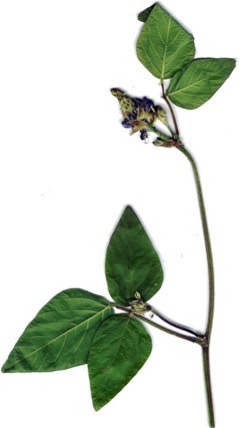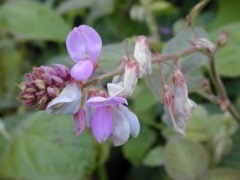 |
|
Forest Starr & Kim Starr starrenvironmental.com |
 |
| Forest Starr & Kim Starr starrenvironmental.com |
Translate this page:
Summary
A long-lived prostrate, scrambling vine with stems up to 1.5 m long with a strong taproot. Occasionally a semi-upright shrubby plant growing 0.5m tall.
Physical Characteristics

 Desmodium intortum is an evergreen Perennial growing to 1.5 m (5ft) by 0.2 m (0ft 8in) at a fast rate.
Desmodium intortum is an evergreen Perennial growing to 1.5 m (5ft) by 0.2 m (0ft 8in) at a fast rate.
See above for USDA hardiness. It is hardy to UK zone 10.
It can fix Nitrogen.
Suitable for: light (sandy), medium (loamy) and heavy (clay) soils. Suitable pH: mildly acid and neutral soils and can grow in very acid soils.
It can grow in full shade (deep woodland) semi-shade (light woodland) or no shade. It prefers moist or wet soil.
UK Hardiness Map
US Hardiness Map
Synonyms
Desmodium galapagense B.L. Rob. Desmodium hjalmarsonii (Schindl.) Standl. Desmodium trigonum DC. Desmodium sinclairii Benth. Desmodium trigonum DC. Hedysarum intortum Mill. Hedysarum trigonum Sw. Meibomia intorta (Mill.) S.F.Blake. Meibomia trigona F.W.Gandara. Meibomia hjalmarsonii Schindl.
Plant Habitats
Edible Uses
References More on Edible Uses
Medicinal Uses
Plants For A Future can not take any responsibility for any adverse effects from the use of plants. Always seek advice from a professional before using a plant medicinally.
None Known
References More on Medicinal Uses
The Bookshop: Edible Plant Books
Our Latest books on Perennial Plants For Food Forests and Permaculture Gardens in paperback or digital formats.

Edible Tropical Plants
Food Forest Plants for Hotter Conditions: 250+ Plants For Tropical Food Forests & Permaculture Gardens.
More

Edible Temperate Plants
Plants for Your Food Forest: 500 Plants for Temperate Food Forests & Permaculture Gardens.
More

More Books
PFAF have eight books available in paperback and digital formats. Browse the shop for more information.
Shop Now
Other Uses
Fodder
Long-term and irrigated pastures for hay and silage - provides good standover feed during autumn and winter in frost-free areas. Very palatable and tends to be heavily grazed. Cut-and-carry systems, and as ground cover. DM yields range from 12 to 19 t/ha/year, which is higher than silverleaf desmodium (7-9 t DM/ha/year). Better yields are obtained with longer cutting intervals of 30-85 days [418]. A good groundcover covering the soil in 4 months. It has been used as ground cover on coffee plantations. Carbon Farming Solutions - Agroforestry Services: nitrogen, understory legume. Fodder: pasture (Agroforestry is a land use management system in which trees or shrubs are grown around or among crops or pastureland).
Special Uses
Carbon Farming
References More on Other Uses
Cultivation details
Agroforestry Services: Contour hedgerow Agroforestry Services: Nitrogen Agroforestry Services: Understory legume Fodder: Pasture Management: Fodder Minor Global Crop
Climate: tropical, tropical highlands. Humidity: semi-arid to humid. Desmodium intortum will grow on a wider range of soils than will D. uncinatum , from sands, light loams to medium clays, but prefers moderate fertility and pH above 5.0. Not tolerant of salinity or high Al and Mn. Requires >900mm rainfall with a moderate dry season of less than 6 months, but will grow under much wetter conditions (>3,000 mm). Tolerance to waterlogging or flooding is better than D. uncinatum . Withstands hot weather better than D. uncinatum. Frost-susceptible. Optimum growth at 30/25°C ±3°C. Good shade tolerance. Carbon Farming Solutions - Cultivation: minor global crop. Management: fodder (Describes the non-destructive management systems that are used in cultivation) [1-1].
Carbon Farming
-
Agroforestry Services: Contour hedgerow
Alley cropping systems on the contour of slopes.
-
Agroforestry Services: Nitrogen
Plants that contribute to nitrogen fixation include the legume family – Fabaceae.
-
Agroforestry Services: Understory legume
Legume vegetation, especially the trees and shrubs growing between the forest canopy and the forest floor.
-
Fodder: Pasture
Enclosed tracts of farmland mainly of grasses, with an interspersion of legumes and other forbs (non-grass herbaceous plants).
-
Management: Fodder
Non-destructive management systems maintaining the soil organic carbon.
-
Minor Global Crop
These crops are already grown or traded around the world, but on a smaller scale than the global perennial staple and industrial crops, The annual value of a minor global crop is under $1 billion US. Examples include shea, carob, Brazil nuts and fibers such as ramie and sisal.
References Carbon Farming Information and Carbon Sequestration Information
Temperature Converter
Type a value in the Celsius field to convert the value to Fahrenheit:
Fahrenheit:
The PFAF Bookshop
Plants For A Future have a number of books available in paperback and digital form. Book titles include Edible Plants, Edible Perennials, Edible Trees,Edible Shrubs, Woodland Gardening, and Temperate Food Forest Plants. Our new book is Food Forest Plants For Hotter Conditions (Tropical and Sub-Tropical).
Shop Now
Plant Propagation
Seed germinates quickly (3-4 days) without scarification.
Other Names
If available other names are mentioned here
Greenleaf desmodium, Beggarlice, Greenleaf tick trefoil, Tickclover; Grünes desmodium (German); Pega pega, Amor seco, Desmodio verde (Spanish); Desmodie (French); Karikuy-ritkuk (Philippines); Thua kleen leap (Thailand).
Native Range
NORTHERN AMERICA: Mexico (Nuevo León, Sonora, Chiapas, Colima, Guerrero, Hidalgo, Jalisco, México, Michoacán de Ocampo, Morelos, Nayarit, Oaxaca, Puebla, Querétaro, Veracruz de Ignacio de la Llave) SOUTHERN AMERICA: Hispaniola, Jamaica, United States (Puerto Rico), Belize, Costa Rica, Guatemala, Honduras, Nicaragua, Panama, El Salvador, Venezuela, Colombia, Ecuador (Azuay, Bolívar, Carchi, Chimborazo, Cotopaxi, Esmeraldas, Guayas, Imbabura, Loja, Los Ríos, Manabí, Morona Santiago, Napo, Pastaza, Pichincha, Tungurahua, Zamora Chinchipe), Peru
Weed Potential
Right plant wrong place. We are currently updating this section.
Please note that a plant may be invasive in one area but may not in your area so it's worth checking.
Can be invasive in all it's growing areas. Regarded as an environmental weed in Queensland and northern New South Wales, Australia. It is mainly of concern in riparian vegetation, due to its shade tolerance and its ability to climb over other plants. This species was recently ranked among the 200 most invasive plants in south-eastern Queensland.
Conservation Status
IUCN Red List of Threatened Plants Status : Status: Least Concern

Growth: S = slow M = medium F = fast. Soil: L = light (sandy) M = medium H = heavy (clay). pH: A = acid N = neutral B = basic (alkaline). Shade: F = full shade S = semi-shade N = no shade. Moisture: D = dry M = Moist We = wet Wa = water.
Now available:
Food Forest Plants for Mediterranean Conditions
350+ Perennial Plants For Mediterranean and Drier Food Forests and Permaculture Gardens.
[Paperback and eBook]
This is the third in Plants For A Future's series of plant guides for food forests tailored to
specific climate zones. Following volumes on temperate and tropical ecosystems, this book focuses
on species suited to Mediterranean conditions—regions with hot, dry summers and cool, wet winters,
often facing the added challenge of climate change.
Read More
Expert comment
Author
(Mill.) Urb.
Botanical References
Links / References
For a list of references used on this page please go here
Readers comment
| Add a comment |
|
If you have important information about this plant that may help other users please add a comment or link below. Only comments or links that are felt to be directly relevant to a plant will be included. If you think a comment/link or information contained on this page is inaccurate or misleading we would welcome your feedback at [email protected]. If you have questions about a plant please use the Forum on this website as we do not have the resources to answer questions ourselves.
* Please note: the comments by website users are not necessarily those held by PFAF and may give misleading or inaccurate information.
To leave a comment please Register or login here All comments need to be approved so will not appear immediately.
|
Subject : Desmodium intortum
|
|
|
|